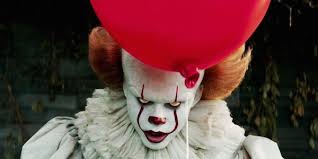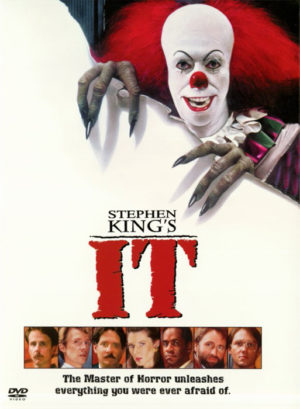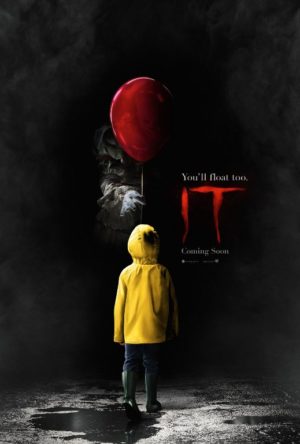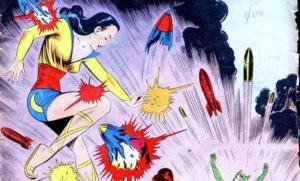Newest ‘It’ film retells King’s masterpiece

Pennywise the dancing clown terrorizes the people of Derry in Stephen King’s novel “It.” With the release of the 2017 “It” movie, there are now two film adaptations of the original novel.
September 24, 2017
A young boy spots a friendly clown in a storm drain after losing his paper boat. A few minutes later, this boy is missing an arm and dead in the street. Welcome to Stephen King’s greatest horror novel, “It.”
The master of horror, Stephen King, finished his eighteenth novel “It,” in 1986. At over 1,000 pages long and written in five parts with five different interludes, “It” has been described as the “Moby-Dick” of horror novels. The first film adaptation of “It” was a television miniseries-movie created by Warner Brothers Television in 1990. This year, Warner Brothers Studios has released a pure movie adaptation of the first half of the story.
With three versions of this story now available, it can be hard to decide which is best. There are a lot of questions to answer. Was the book better than this movie? Was the old movie better than the reboot? Was the old movie better than the book? There’s a lot to discuss.

The Clown
There’s no better place to start than with the friendly face of the horrific killer living beneath Derry, Maine. Pennywise the Dancing Clown is the preferred form of the creature known as It, when not taking the form of whatever scares you most. Pennywise is everything a good horror story antagonist should be: near unstoppable, bloodthirsty, and terrifying.
In the book, whenever It appears as Pennywise, It is happy, funny, and murderous. Pennywise wears a silver clown suit with orange pompoms and is often seen with a balloon in his hand and a smile on his face. Anyone who wants to know which Pennywise is the best of the three will find that it’s the book version. Obviously. There’s simply more content, more killings, and more to enjoy from the book Pennywise than can be crammed into a single film.
Every Pennywise has the same core elements that make him a fantastic villain to watch or read about. Each Pennywise also terrorizes the Loser’s Club by becoming what they fear most. At the same time, Pennywise always seems to be enjoying himself immensely, as if he’s playing with his food before eating it. This is a huge part of what makes Pennywise scary for both the characters in the story and the audience: he’ll rip you to pieces with a smile on his face. Tim Curry (1990 film) and Bill Skarsgård (2017 film) both captured this aspect of Pennywise excellently as they terrorized the children of Derry.
Between the movies, the debate over which Pennywise is better is currently raging across the internet. Both Skarsgård and Curry brought spectacular performances to their respective movies. Tim Curry was given a more comical script that is packed with lines such as “Kiss me, fat boy!” while Bill Skarsgård’s Pennywise is dialed back a bit to make him scarier. However, both actors manage to deliver their lines in the most spectacularly hilarious yet horrifying manner. The way each actor does this is different, so both movie versions of Pennywise seem fundamentally distinct, yet impressive in their own right.
Any differences in these killer clowns are not due to inadequacies from the actors, but simply due to the inevitable changes in moviemaking between 1990 and 2017. After twenty-seven years of improvement in special and practical effects technology, Skarsgård’s Pennywise is visually scarier beyond question. Curry’s Pennywise is terrific, but he simply doesn’t have the anglerfish style teeth or yellow eyes that can fully rotate around in their sockets.
The Fear
Even though both big screen adaptations of “It” are scary, the book wins when it comes to the fear factor. This may be hard to believe. A book does not have jump-scares. A book cannot set the atmosphere with music the way movies do. These are true statements. However, the original “It” novel manages to hook the reader like a fish and pull them down into the darkness instead of up into the light. Readers will not be screaming with fright while reading “It,” but if they let the novel capture their imagination, they will be thinking twice before turning out the lights at night.
“It” is a novel that reveals much more than what appears on the surface. “It” is more than a story of seven people fighting a gruesome creature disguised as a clown. It’s a story about the inevitability of death, the sad truths of growing older, and the immense fear one finds when facing something far larger and more powerful than themselves. When reading a book with such intense, existential themes in addition to the constant mortal danger the characters are placed in, one cannot help but be afraid.
Both films only manage to capture a small sliver of the depth of the book in these areas. As far as horror movies go, they are both scary. The 1990 version won’t scare today’s generation nearly as much as the latest movie, but that’s due to how the genre has evolved over the years. Today, a friendly clown can morph into a horrific monster on screen before attacking a group of children. In 1990, the best that could be done was to give Tim Curry false teeth and glowing eyes.
The Plot
There is not much to comment on regarding how the plot compares between the three versions. Both movies include everything they can, ensuring that the core events of the plot are there in some form and that the story runs mostly parallel to the book. Of course, a book of such size holds far more than can be fit into several hours of screen time.

The movies are adaptations of the novel, not perfect copies with minor events trimmed out. However, most of the changes are insubstantial. The 1990 movie and the 2017 movie changed the way that It appeared to several members of the Loser’s Club to help match the fears of audience members in their respective time periods. The perfect example is Ben, the fat character in the story. In the book, he sees It as a mummy. In the 1990 “It,” he saw It as his dead father. In the 2017 “It,” he sees It as a headless boy. These changes help create a functional movie that is appropriate for when it was made without dishonoring the source material.
The Loser’s Club
The final aspect of this epic story to compare is the main characters of “It” — The Loser’s Club of Derry. For each character, the Pennywise rule still stands as the book has more content than any movie can include. The characterization in the novel is in-depth and spectacular, and fortunately, both movies have been able to recreate this on a smaller scale.
The Loser’s Club consists of seven members, each of them labeled a loser for a varying reason. Bill Denbrough stutters when he speaks. Eddie Kasprak is an asthmatic on all sorts of medication. Richie “Trashmouth” Tozier is the master of doing various voices and breaking his glasses. Ben Hanscom is the fattest kid in all of Derry. Beverly Marsh is dirt poor and living with her abusive father. Stanley Uris is Jewish, and Mike Hanlon is part of the only black family in Derry.
In the 1990 movie, these seven children are played by a delightful team of actors (and one actress) to bring these characters to life for the first time. Each character has the same qualities, motivations, and development that they do in the book. Of course, not everything from the original story could be included, but the Loser’s Club is still the Loser’s Club when all is said and done. Overall, for a 1990 TV miniseries, the older “It” delivers.

This does not mean that the newest “It” cannot blow the old one out of the water. The cast of the 2017 “It” captures the heart, humor, and childhood camaraderie that makes the characters so lovable in the original novel. Fans arrived at the theater expecting to scream in terror but were pleasantly surprised when they also roared with laughter at the comedic moments, most of which were delivered by Finn Wolfhard’s Richie Tozier.
What makes the performances of the older and newer cast members more impressive is that in both cases, many of the child actors were small-time, rising actors who had never had a part in a project on this scale before. Warner Bros. Studios intentionally did this for the newer film, choosing to let the quality of the film and the Stephen King name attract viewers instead of just casting expensive, better-known actors and actresses. In retrospect, it’s a strategy that paid off.
Which version of “It” is the best? A goliath-sized novel by the master of horror, a classic movie almost three decades old, or the modern edition of the story on the big screen? It depends, but no matter how Stephen King fans choose to experience “It,” they’re guaranteed to witness a story that will stick with them for life.







